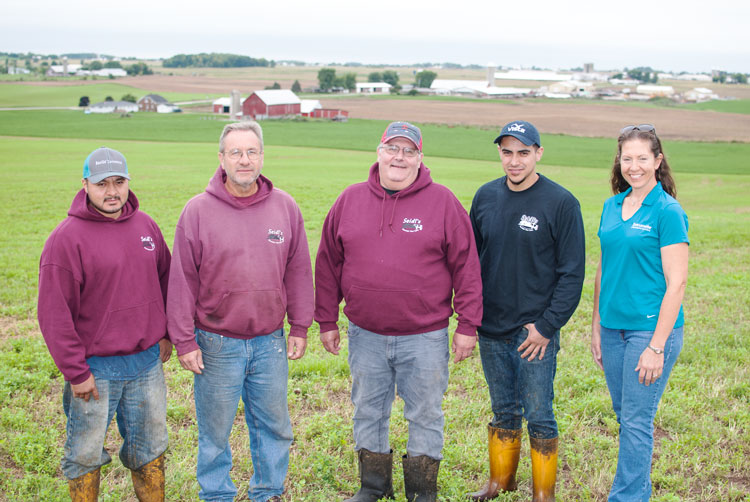
"All cows enter the presynch program. All repeat breeders confirmed at herd check are enrolled in ovsynch,” said Steve Paider, dairy manager for Seidl’s Mountain View Dairy of Luxemburg, Wis. “All second repeats get a double prostaglandin, and repeat breeders are double bred to semen,” added the two-time Platinum winner of the Dairy Cattle Reproduction Council’s (DCRC) annual awards competition.
As for reproductive metrics from Seidl’s Mountain View Dairy:
62 percent conception rate (CR) on ovsynch
50 percent CR on standing heat
57 percent CR on presynch
56 percent CR on double prostaglandin
59 percent of the herd is pregnant at first service
1.6 services per conception
Calving interval is 12.1 months
All six of this year’s Platinum winners of the Dairy Cattle Reproduction Council’s awards share additional insight in this Hoard’s Dairyman Intel as well as the Round Table found on pages 679 to 682 of the November issue of Hoard’s Dairyman. This year’s competition drew the second-largest set of nominations to date — 102 — from 15 U.S. states and seven countries found on four continents.
Here are additional responses to the question, “Do you use an ovulation or heat synchronization program?”
Holmesville Dairy, Argyle, Wis.: All cows are ultrasounded by our veterinarian, B.J. Jones, at 32 and 55 days postbreeding. If cows are open and have a corpus luteum (CL), they are resynchronized with an ovsynch protocol. If the cow is open with no CL, we give GnRH and recheck the cow for a CL the next week. If a CL is present, ovsynch will begin.
If our heifers are not bred by 13-1/2 months, we will ultrasound them. Heifers with CLs are given prostaglandin, while heifers with no structure are given GnRH and checked in one week for a CL.
We have been very happy with our conception rates and pregnancy rates with this system. Overall herd pregnancy rate is 38 percent, heat detection rate is 72 percent, and conception rate of 56 percent.
Pendora Dairy, Monkton, Ontario, Canada: When we started with pedometers and activity monitors in 2008, we discontinued all synchronization programs.
Rollin’ Green Dairy, Brooklyn, Wis.: We utilize the double ovsynch protocol for the first service on every cow. If a natural heat is missed and a cow comes up open on Day 32 (vet check day), we will start the ovsynch protocol a second time. If a cow still isn’t pregnant after two services, we employ CIDR synch. Beef semen is used on all third services.
Changes have been made in the last few years to help our pregnancy rate climb substantially: A.I. retraining, 21-day interval for when cows are painted, cows are walked three times a day and aggressively heat detected, the voluntary waiting period was backed off to 77 days, and two prostaglandins are given during ovsynch protocol. No matter what protocol gets used, it needs to be followed through exactly. We strive to stay very organized as to what has to be done on a day-to-day basis.
As far as the heifers, they are given prostaglandin. If no heat is observed, they receive a second prostaglandin 14 days later. They always receive an Estrotect sticker with each prostaglandin and at 21 days postbreeding. Tail paint doesn’t seem to work with heifers for us, as they won’t leave it alone and lick it off. Heifers are in the A.I. breeding pen for a month and are then moved into a pen with the bull.
Schilling Farms, Darlington, Wis.: Heifers enter the breeding pen at 13 months of age and are bred by visual inspection of the Estrotect patch applied by the Genex team. Heifers are ultrasounded at 28 days postinsemination, and if found open with a CL, are given prostaglandin.
Lactating cows are all bred on an ovsynch 48-hour program for first service. All cows are started on ovsynch at 77 DIM. GnRH 1 (Cystorelin 4 cc) is given Tuesday morning, prostaglandin 1 (Lutalyse 5 cc) is given seven days later on Tuesday morning, a second prostaglandin (5 cc) is given 24 hours later on Wednesday morning, and GnRH2 (2 cc) is given 48 hours after the first prostaglandin on Thursday morning. Breeding is done Thursday, eight hours after the morning GnRH.
Open cows are resynched with a similar program at herd health. If a CL is present, ovsynch is started. If a CL is not present, 4 cc of GnRH is given, and ovsynch is started seven days later.
Our overall pregnancy rate with these methods is currently 39 percent with an overall 57 percent conception rate. Approximately 64 percent of our breedings are synchronized with a 59 percent conception rate. At our farm, 8 percent of cows are classified by standing heat with a 51 percent conception rate. Finally, 28 percent are classified as chalk breedings with a 55 percent conception rate.
Victory Farms, Milbank, S.D.: All first-service cows receive double ovsynch. Open cows get a five-day CIDR program. New heifers are enrolled daily with a prostaglandin (Lutalyse HighCon) and repeated every 11 days until serviced. After three prostaglandins, heifers receive a five-day CIDR program. Both programs were started in the last couple years with great success.
This Hoard’s Dairyman Intel article is part of a seven-part series detailing top reproduction tips from the Platinum winning herds for the 11th annual Dairy Cattle Reproduction Council awards competition.
Click below to view previous reports from this DCRC series:
He checks for heats morning, noon, and night
Our presynch protocol sets the stage








